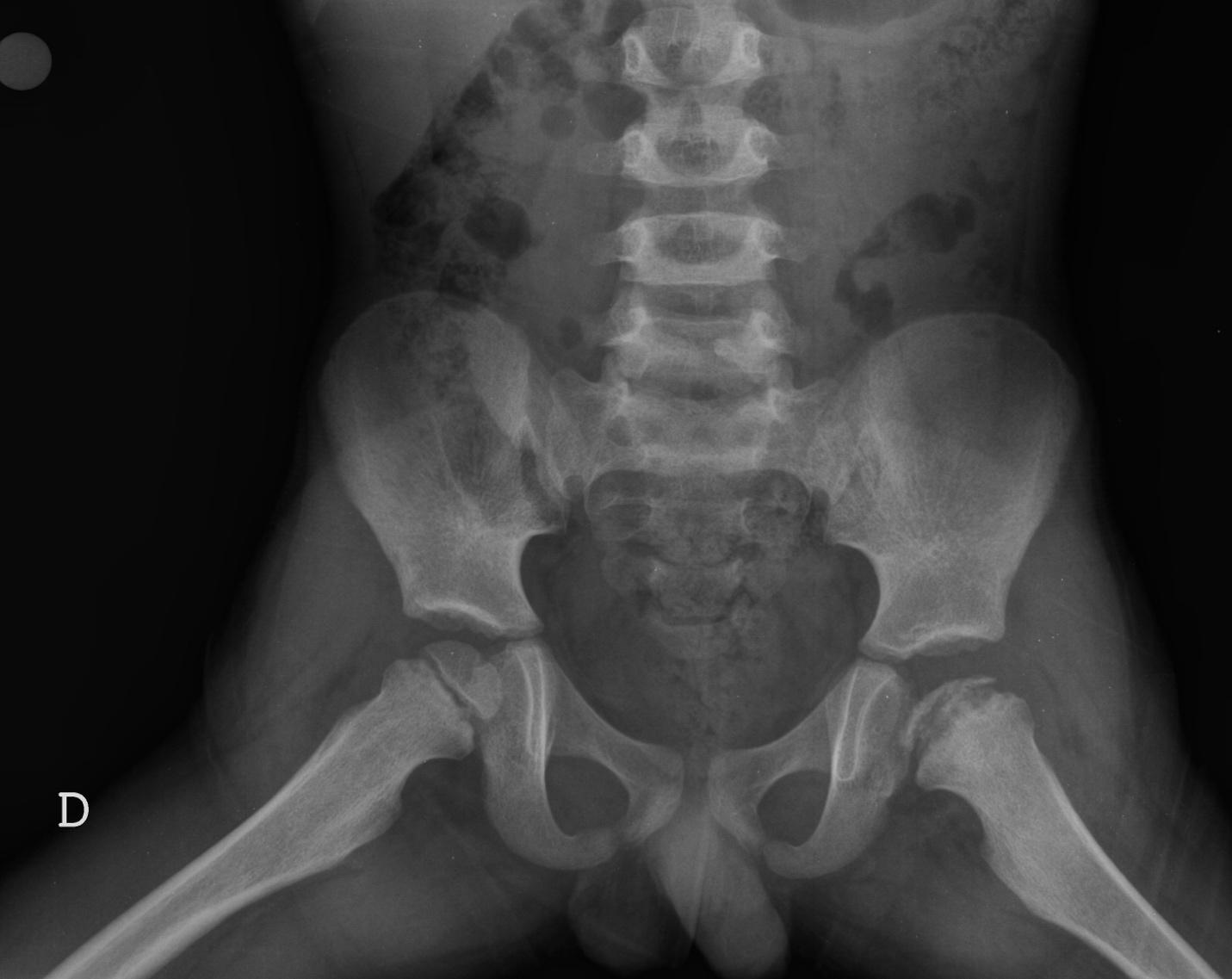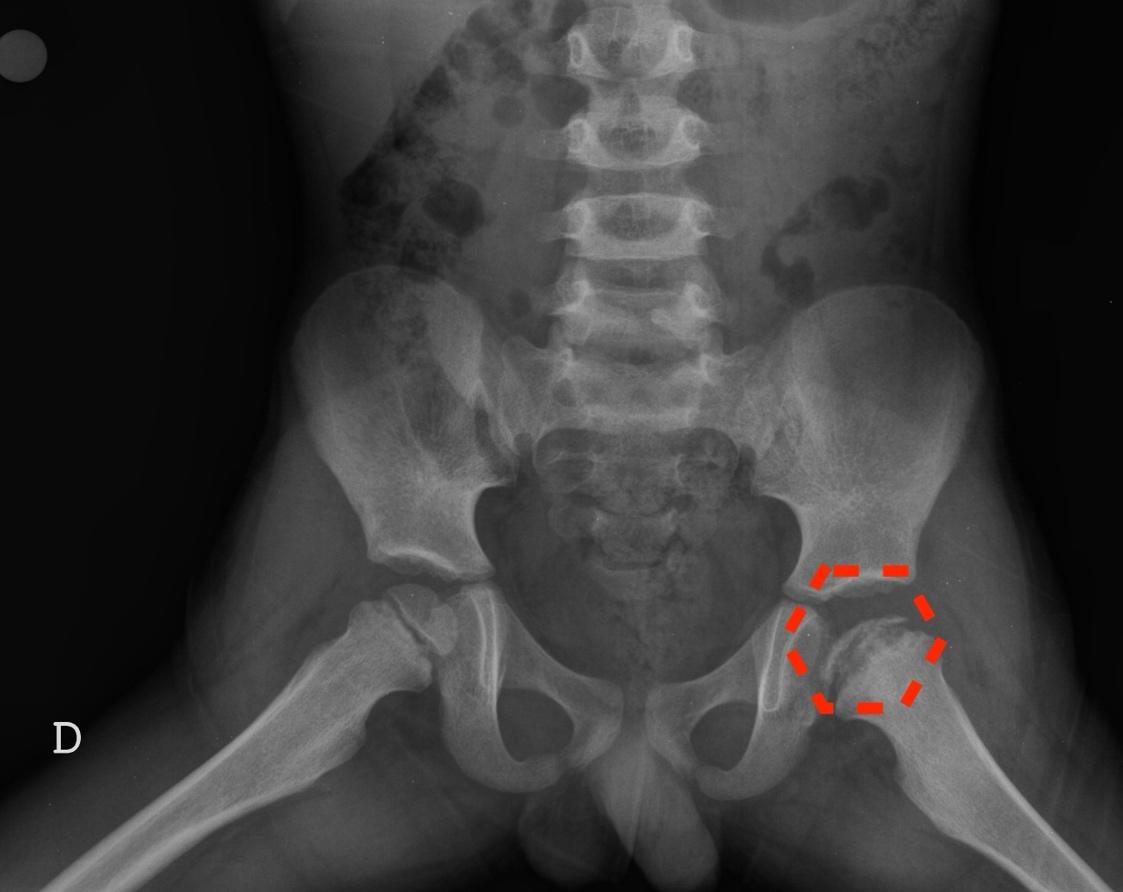A Real Kick in the Hip
Author: Robert Woodruff, DO
Peer-Reviewer and Final Editor: Alex Tomesch, MD, CAQ-SM
A 7-year-old male presents with progressively worsening left hip pain and limp when playing soccer. Pain was previously relieved by rest but has now become constant.

Image 1. Case courtesy of Bruno Di Muzio, Radiopaedia.org, rID: 12153
What is your diagnosis?
Legg-Calve-Perthes (LCP) disease
- Pearl: LCP is a disease of the hip caused by avascular necrosis of the femoral head. Early stages of LCP are often not identifiable on X-ray and will only be detected by MRI, however as the disease progresses X-ray imaging can be useful [1]. In late stages x-ray will show joint space widening, increased lucency of the femoral head, and flattening and fragmentation of the femoral head (red dotted line, image 2).

Image 2. Annotations by Author. Case courtesy of Bruno Di Muzio, Radiopaedia.org, rID: 12153
What pathological injury can cause this finding? How can you rule it out?
LCP is associated with multiple risk factors that can predispose one to developing the disease, the most common risk factors are repetitive microtrauma, bleeding disorders, children born small for gestational age and/or with breech presentation [2] and environmental factors such as second hand smoke exposure [3]. While the etiology of LCP remains undefined, the pathophysiology is thought to result from a mismatch between growth of the femoral epiphyses and the slower development (or sometimes disruption) of vascular support to the area.
What Physical Exam findings are expected?
The diagnosis of LCP requires a high degree of clinical suspicion. Physical exam findings include decreased internal rotation and abduction of the hip, leg length discrepancy, and pain on rotation referred to the anteromedial thigh and/or knee [4]. Gait evaluation may find short-stance and/or Trendelenburg gait [4]
What is your disposition and management? Do I need an urgent Orthopedic consult?
Once the diagnosis of LCP has been made, the goal is to limit microvascular trauma and patients should be non-weight bearing while referral to pediatric orthopedic surgeon is made [5]. Emergent Orthopedic consultation is not typically required, but this may be system dependent. Treatment options typically consist of using braces and splints to contain the femoral head within the acetabulum or surgery [6]. Most patients experience improvement in pain initially, however long-term outcomes depend on age of onset (older than 6 y/o is less favorable) and the degree to which the femoral head was necrosed (greater than 50% is less favorable) [7,8].
References
[1] Dillman JR, Hernandez RJ. MRI of Legg-Calve-Perthes disease. AJR Am J Roentgenol. 2009;193(5):1394-1407. doi:10.2214/AJR.09.2444
[2] Lindblad M, Josefsson A, Bladh M, Sydsjö G, Johansson T. Risk factors during pregnancy and delivery for the development of Perthes' disease, a nationwide Swedish study of 2.1 million individuals. BMC Pregnancy Childbirth. 2020;20(1):192. Published 2020 Mar 30. doi:10.1186/s12884-020-2849-7
[3] Gao H, Huang Z, Jia Z, et al. Influence of passive smoking on the onset of Legg-Calvè-Perthes disease: a systematic review and meta-analysis. J Pediatr Orthop B. 2020;29(6):556-566. doi:10.1097/BPB.0000000000000725
[4] Dobbe AM, Gibbons PJ. Common paediatric conditions of the lower limb. J Paediatr Child Health. 2017;53(11):1077-1085. doi:10.1111/jpc.13756
[5] Ibrahim T, Little DG. The Pathogenesis and Treatment of Legg-Calvé-Perthes Disease. JBJS Rev. 2016;4(7):e4. doi:10.2106/JBJS.RVW.15.00063
[6] Sankar WN, Lavalva SM, Mcguire MF, et al. Does Early Proximal Femoral Varus Osteotomy Shorten the Duration of Fragmentation in Perthes Disease? Lessons From a Prospective Multicenter Cohort. J Pediatr Orthop. 2020;40(5):e322-e328. doi:10.1097/BPO.0000000000001451
[7] Wiig O, Huhnstock S, Terjesen T, Pripp AH, Svenningsen S. The outcome and prognostic factors in children with bilateral Perthes' disease: a prospective study of 40 children with follow-up over five years. Bone Joint J. 2016;98-B(4):569-575. doi:10.1302/0301-620X.98B4.36045
[8] Yrjönen T. Long-term prognosis of Legg-Calvé-Perthes disease: a meta-analysis. J Pediatr Orthop B. 1999;8(3):169-172. doi:10.1097/01202412-199907000-00005


